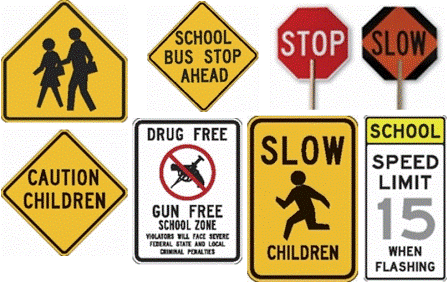


Traffic signals help provide for the orderly movement of traffic. Drivers must obey these signals, except when a law enforcement officer is directing traffic. You must obey a law enforcement officer at all times when they are directing traffic even if he/she is telling you to do something which is ordinarily considered against the law. Understanding traffic signs, signals, and markings are vital to your safety on the road and major part of defensive driving education.
Steady Red Light (Stop)
Stop before entering the crosswalk or intersection. You may turn right unless prohibited by law. You may also turn left if both streets are one way, unless prohibited by law. You must yield to all pedestrians and other traffic lawfully using the intersection.
A Flashing Red Light
Stop completely before entering the crosswalk or intersection, and then proceed when you can do so safely. Vehicles on the intersecting road may not have to stop.
Steady Yellow Light (Caution)
A steady yellow light warns drivers to use caution and to alert them the light is about to change to red. You must STOP before entering the nearest crosswalk at the intersection if you can do so safely. If a stop cannot be made safely, then you may proceed cautiously through the intersection before the light changes to red.
A Flashing Yellow Light
A flashing yellow light warns drivers to slow down and proceed with caution.
A Flashing Yellow Arrow for Left-Turns
A flashing yellow arrow allows a driver to turn left, but the driver must yield the right-of-way to oncoming traffic.
Steady Green Light (Go)
A steady green light means the driver can proceed on a green light if it is safe to do so. You may drive straight ahead or turn unless prohibited by another sign or signal. Watch for cars and pedestrians in the intersection. Be aware of reckless drivers who may race across the intersection to beat a red light.
Green Arrow Displayed at the Same Time as a Red Light
A green arrow displayed at the same time as a red light means the driver can proceed carefully in the direction of the arrow after yielding the right-of-way to other vehicles and pedestrians.
Left Turn on Green
You can turn left on a green light. However, you must yield the right-of-way to all traffic that is approaching from the opposite direction before turning.
Traffic signs can help you to be a better driver as they
There are 3 types of signs, signals
Colors and shapes of the signs can also help you understand if the sign is regulatory, warning or information.
| Sign Type | Color |
|---|---|
| Regulatory | ■(red) ■ (black) ■ (white) |
| Warning | ■ (green) ■ (blue) ■ (yellow) |
| Information or Guide | ■ (orange) ■ (orange retro reflective) ■ (brown) |
| Sign Type | Shape |
| Regulatory | Octagon, inverted equilateral triangle vertical rectangle |
| Warning | Pennant, Pentagon, diamond, circle |
| Information or Guide | Horizontal rectangle, square |